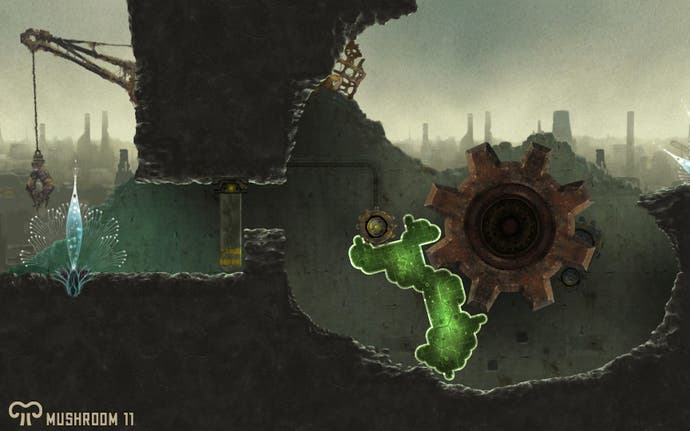Mushroom 11 review
Spore the win.
For a game that can feel so alien, Mushroom 11's premise is comfortingly familiar. Earth has been wrecked, presumably - in light of the game's title - by some kind of nuclear mishap or extravagance. Humanity's infrastructure - the pipes, the rails, the chimneys, the cranes - stoically gather moss or crumble. Life, or what's left of it, has no time to mourn our passing (besides, why on earth would they, with our damned record?). Still, the death of one species provides opportunity for another. The journey will be difficult but, for the gelatinous blob of bacteria you guide through various scenes of Soviet decay, the truism holds: life always finds a way.
Mushroom 11's gift is not its ghoulish, ambient soundtrack, or the artfully arranged backdrops of demolition - although both of these assets contribute a great deal to the melancholic, yet hopeful ambiance. It is, instead, the primary interaction itself. You control the amorphous blob indirectly, by pushing it along the ground via an erase tool. Hold down the button and, like scrubbing out an image in Photoshop, you rub away the underlying blob. The erased section then regrows on the other side of its mass, shifting it slightly along the ground (imagine a picture editor erasing a magazine cover model's hip, only to find it reappear exotically on her shoulder and you get the general idea). Moving the organism in a particular direction is as simple as erasing its opposite side. Scrub the cursory back and forth quickly and you'll create momentum to this action. This, combined with the lay of the terrain, allows you to cause the blob to roll, climb or teeter. Providing one part of the blob is touching a surface, it will always regrow.

There are just two buttons in Mushroom 11. Both perform the same erase function: one with a large cursor, and one with a small. The smaller cursor allows you to perform more delicate rearrangements of cells to, for example, fashion the blob into a tall column to reach a high place, or into a ramp, to allow an incoming bomb to roll over your back and launch off toward a distant target. The smaller cursor also allows you to split the blob into two parts, which can then be independently controlled. From this tiny palette of interactions, spatial reasoning puzzles grow naturally, requiring you to, for example, hit multiple switches simultaneously, or to squeeze through narrow passages or even rebound from the surface of water in order to bounce onto high ledges.
While the puzzles in Mushroom 11 are as static and formal as in any Super Mario game, the loose, imprecise feel of controlling the blob gives them a pleasantly improvised feel. Often you'll frantically scrub the mouse behind the blob, as you attempt to cause it to race up some wall in the hope a few cells will make it to the summit, which can then be used to regrow your bulk in the correct position. At times, and in this particular way, Mushroom 11 skirts close to busywork. One section where you have to roll a boulder across a lava lake by moving your blob in the opposite direction over its surface can cause mounting frustration as you lurch back and forth, singeing yourself, accidentally rolling the boulder the wrong way before, perhaps, finally toppling into the lava and forcing a restart of the section.
There is, in all of the game's various scenes like this, a technique to master, and the designers subtly teach and hone skills that will be necessary later in the game - all without the necessity of intrusive text or structured lessons. When you finally make it through a challenging section, as in all the best puzzle games, your store of patience is reset. You quest onwards, your interest and determination undiminished by recent problems.
Each stage is filled with flies, jellyfish and other simple organisms that will be swallowed up into your bacterial gloop if you manage to touch them. Initially it seems as though these meals will add to your bulk but, presumably for carefully thought through reasons, this isn't the case. They act merely as collectible items. Many are placed in seemingly impossible-to-reach locations, and only the most talented or determined player will collect the set. There are further challenges for the expert player, including awards for those who manage to make it through each stage without dying, a tall challenge, particularly with some of the more demanding end-of-level boss battles. Checkpoints are liberally spaced so those without the fortitude to attempt such feats are able to protect each screen's worth of progress without fear.
Chic, stylish and inventive, Mushroom 11 explores every nook of creative space within the tight boundaries it sets for itself. Behind its protagonist and exotic movement scheme, the game's rhythm structure is as familiar as its setting (puzzle, boss, puzzle - verse, chorus, verse), but this familiarity only serves to heighten its experimental ideas. They shine ever so brightly on the derelict canvas of post-nuclear fallout Russia.



